

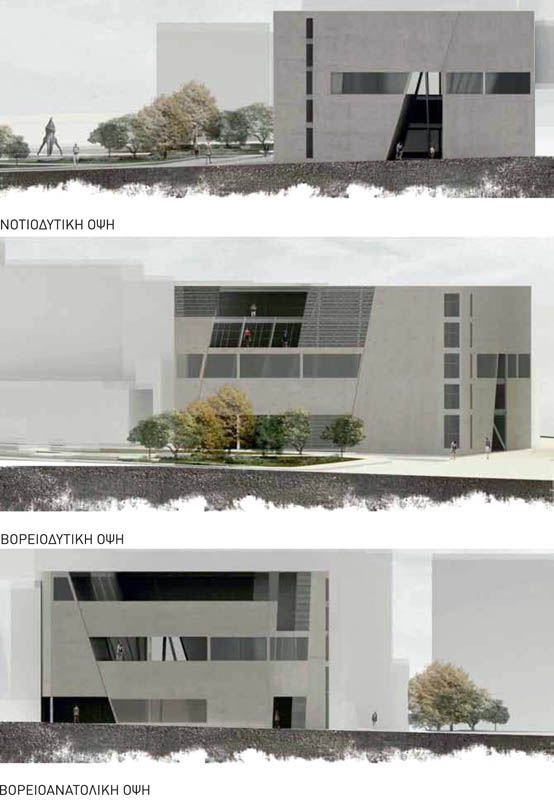

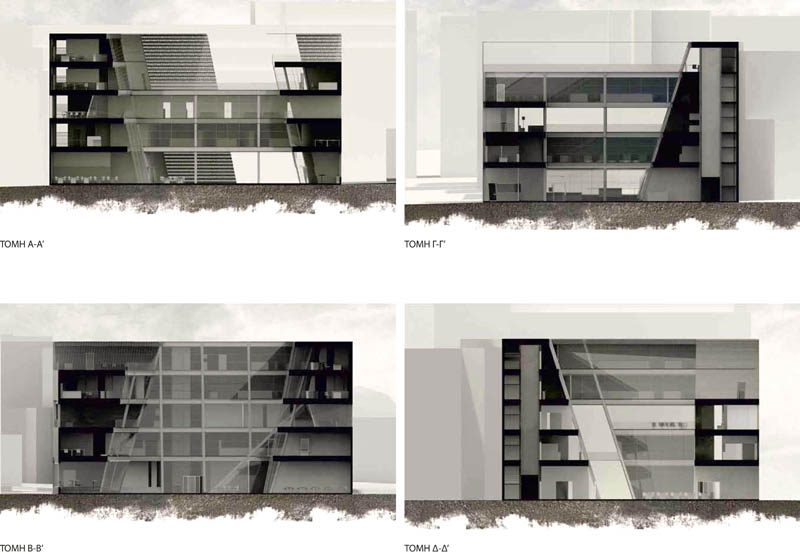



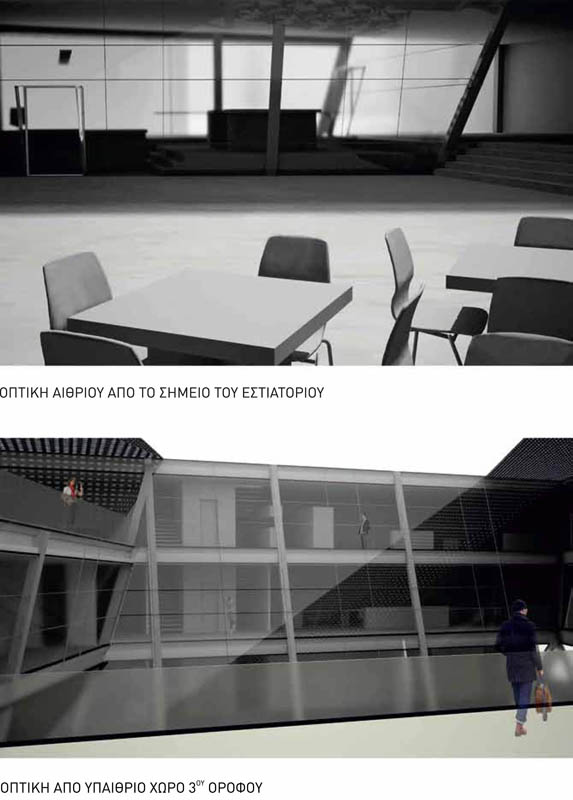

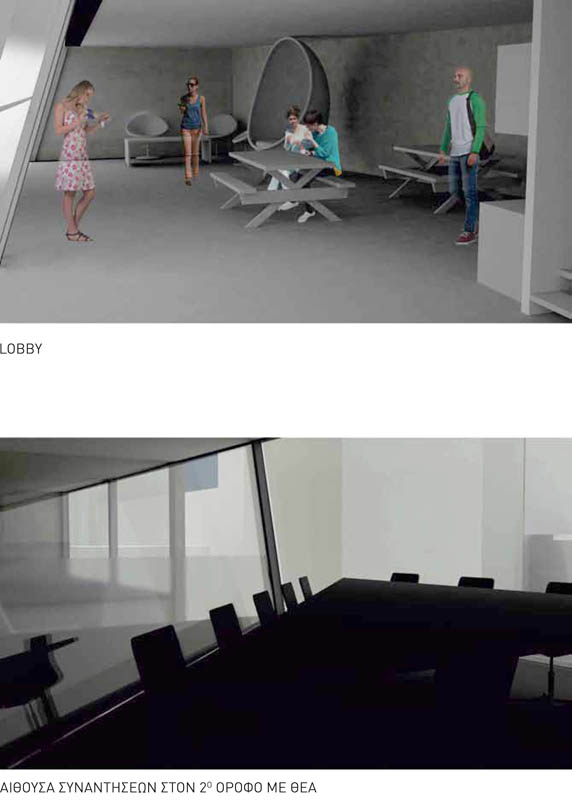

“The Crukinble” is a building which houses a publishing company and activities connected to electronic and printed book. The combination of the various functions is accomplished through the structure, creating a landmark in the center of Athens. It is an active experiment of coexistence of different professions with the least possiblehierarchical distinction among them, simultaneously.
Its designation is a combination of the words: crucible καιkindle. Kindle is, in other words, the tablet. Crucible is used as a term both figuratively and literally, because not only the building’s atrium resembles to this, but also the entire building could be characterized as a place of concentration and dissemination of printed and electronic press.
The main function of the building is the publishing company. The occupations that can be practiced vary. The offices are placed in open plan and there are not isolated ones. The only distinction is based on the sector of work, each section is located in different points of the property, but it is not separated from the other ones. The separation is achieved through panels that can be moved, creating a dynamic space.
Another function is the library, which is accessible to the professionals and the visitors. What is more, there are many rooms for meetings and lectures. Finally, the basic point of the building is the ground floor, where the atrium base and the general public access are located. There are also a showroom and a lyceum capable to house exhibitions and book presentations, transforming the place into a meeting point in Athens.
Supervisors: Tsangrassoulis Aris, Gavrilou Evelyn, Lykourioti Iris
Reference Number: 492
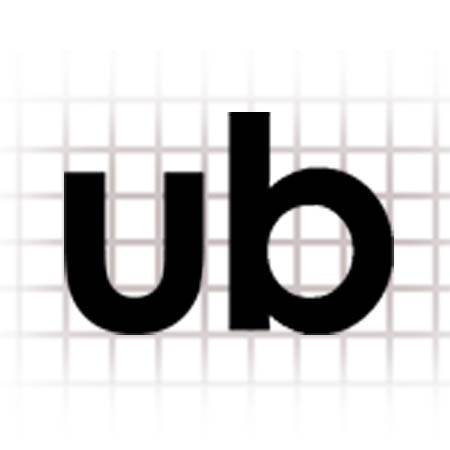

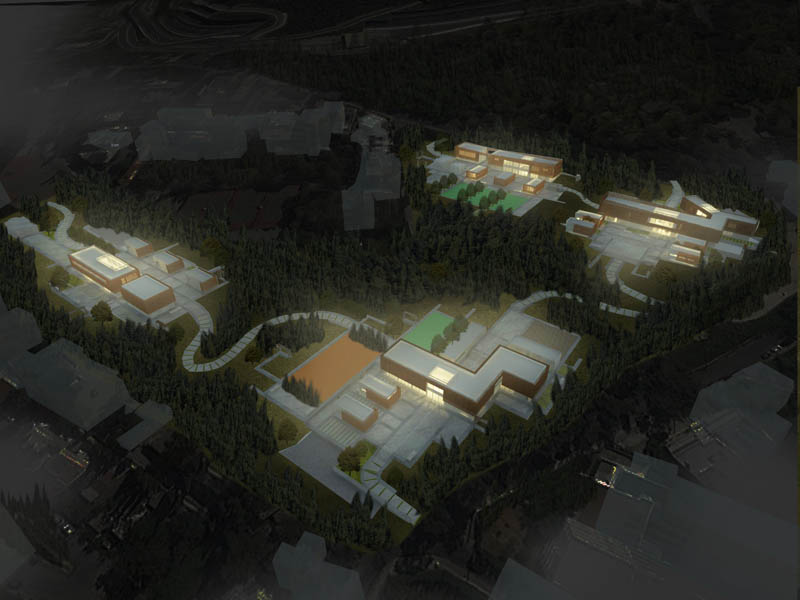

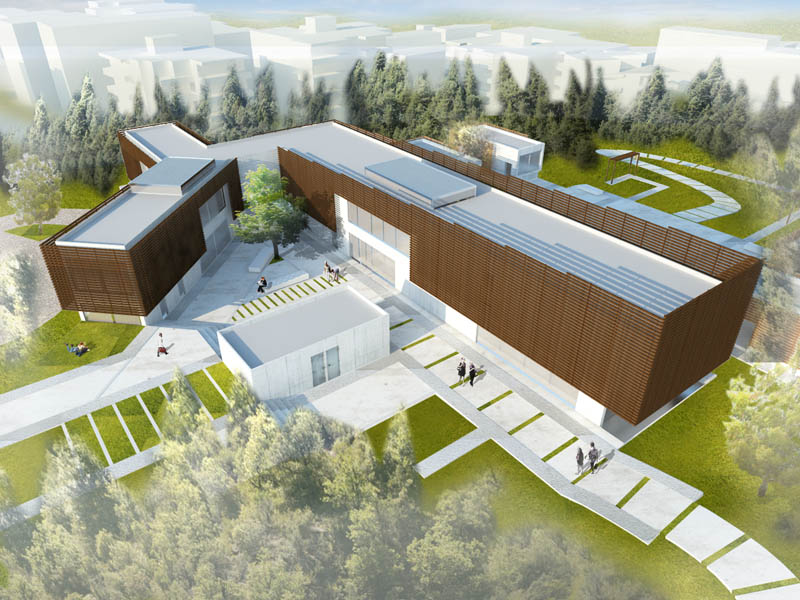

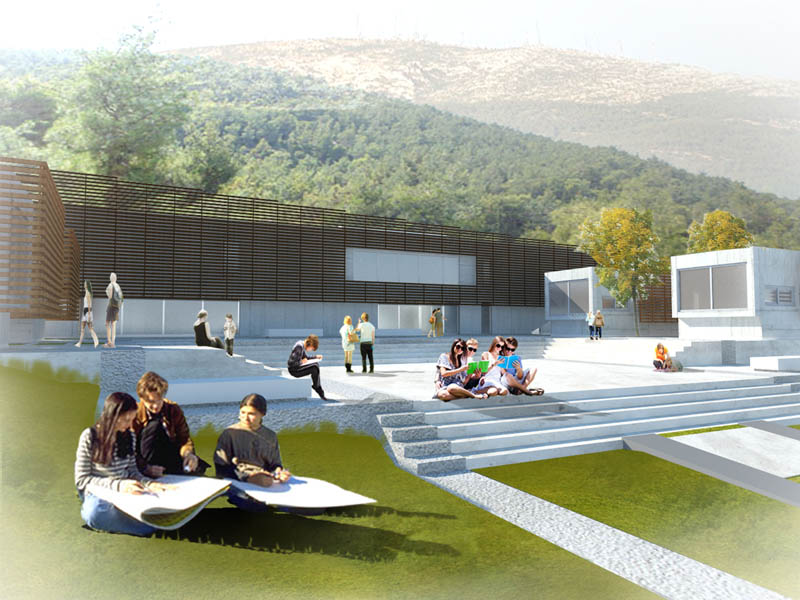

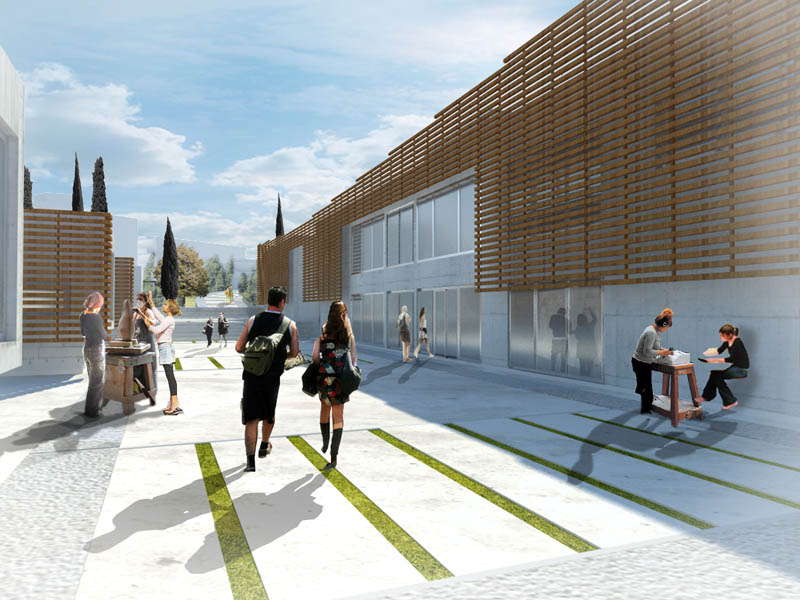

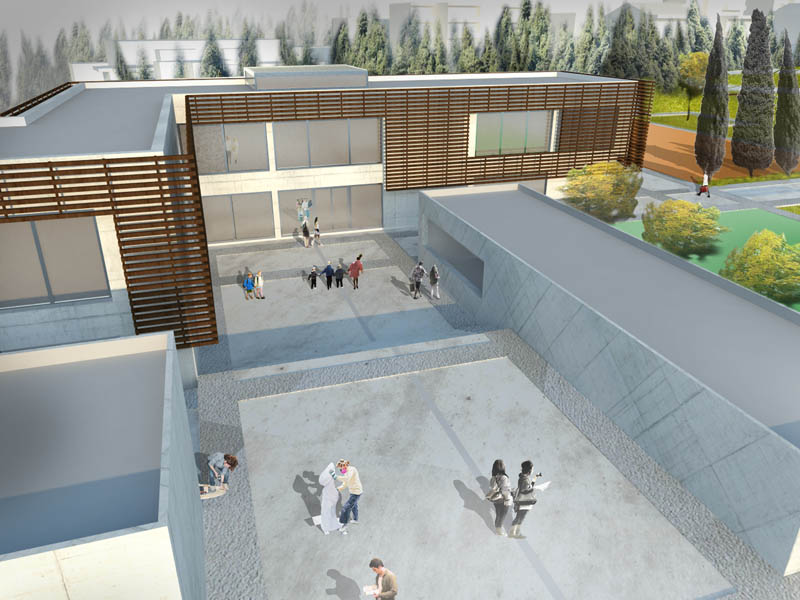

The subject of this diploma project deals with the site of the former Spiroudi military Camp in the Municipality of Ayia Paraskevi in Athens. Situated in the north-eastern part of the area, at the foothills of mount Hymettus and between the apartment blocks around it and the mountain forest, the field currently accommodates the Municipal Art Workshop of Ayia Paraskevi, as well as various sports clubs, by mainly reusing the already existing infrastractures of the former military camp. The main topic and goal of this project is the improvement of the site by maintaining and further upgrading its existing functions through the introduction of a greater art and culture centre, also containing sports facilities and having both local and hyper topical importance.
This 40 acres study area has a very distinct character, with a variety of spatial environments and functions within its space. The apparent contrast between the almost entirely deserted central part of the site and the northern and southern portions of the field which are fully reclaimed, weakens the dynamic and interest of its current function and therefore creates the need to approach this space quite differently. The stress on arts and culture, which already represents the central aspect of the site’s character, could also become the core of an extended intervention. By reclaiming the preferential position of this space within the urban tissue and transforming its weaknesses like its spatial discontinuity and increased ground inclinations, into decisive advantages, the concept of an extended building complex clearly related to artistic and cultural activities is suggested, with a more multifunctional character.
As a result of this prospect/expectation is the composition/introduction of an educational campus containing 4 bubble-like shaped glade areas surrounded by trees. Each one of them emphasizes a different cultural activity, exploiting the location of the site on the borderline separating the city from the mountain forest and smoothly incorporated in a demanding environment.
Supervisor: Trova Vasso
Reference Number: 525


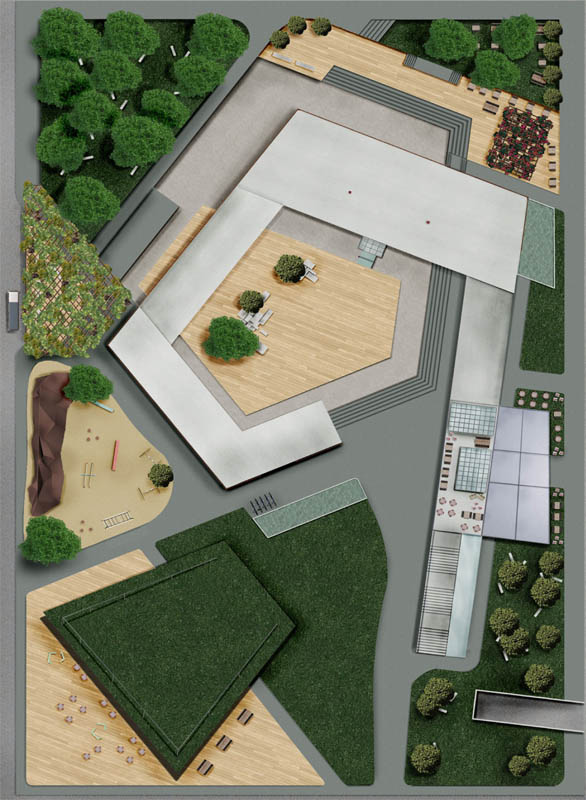

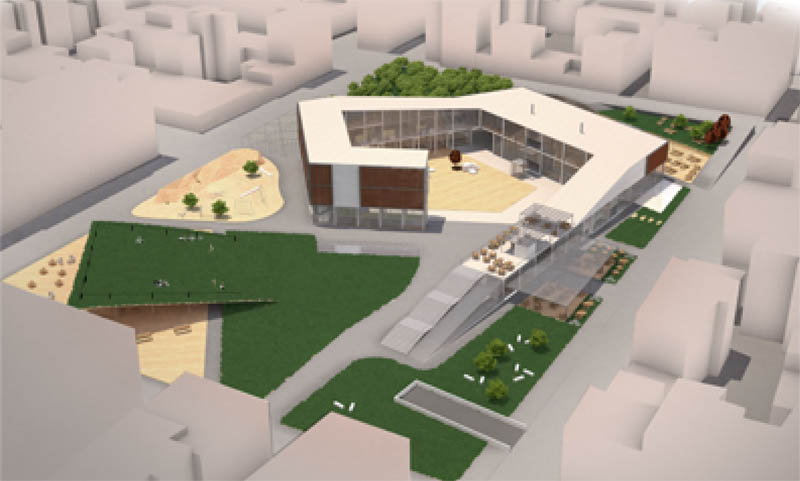



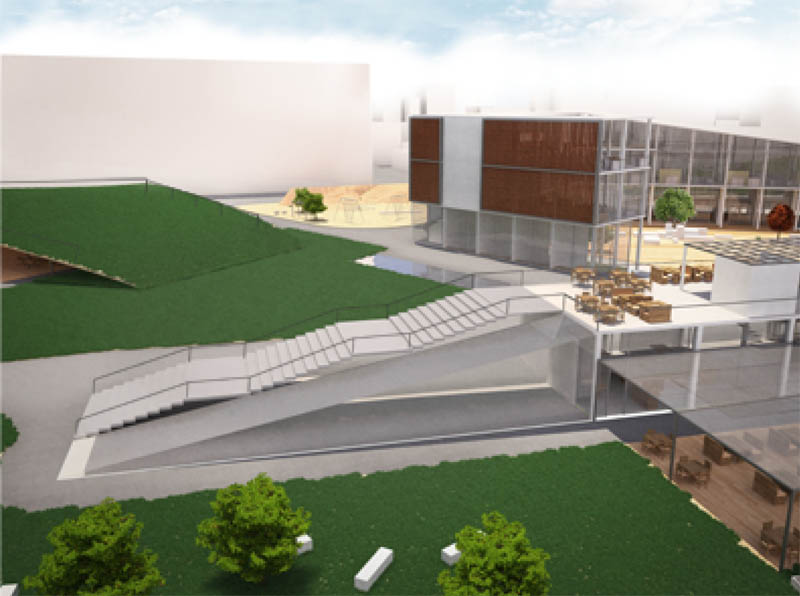

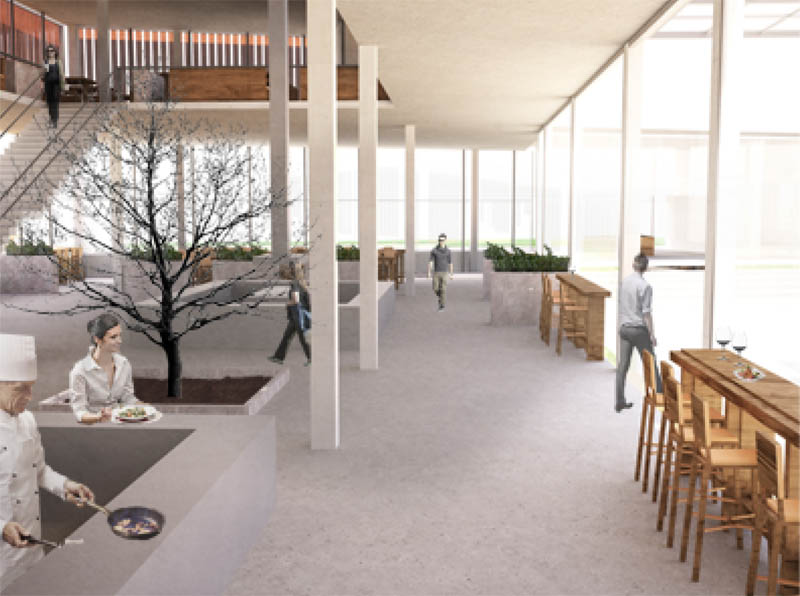

The present thesis discusses the creation of a place ordained for the trade and consumption of edibles in the city of Volos, as well as the conformation of the surrounding public space. The building location is in the city center, aiming to reduce its density and incorporate a stem of flora in the urban landscape.
Our effort concentrates on highlighting the local culture of Volos. Having detected the current problems and having chosen local producers and farmers as the place’s suppliers, we achieve its function without intermediaries, and as a further result, keeping the cost at low levels.
During the realization of this project, similar places were studied and analyzed to their notable features. There was no attempt to copy the examples, but to reflect on them, as to accomplish the maximum on designing the place in the context of Volos.
This feasting and trading multiplex will serve as a model center of encounter of the different elements that compose the heterogeneous canvas of the Greek gastronomy, focusing mainly on the wider Volos area. Farmers, cooks, institutions, visitors and connoisseurs from Greece and beyond will contribute to the cultural and economic development of the region. Our basic aspiration is to further educate the inhabitants on nutritional subjects. Relevant events and cooking lessons for children and adults will conduce to this purpose. At the same time, there’s an attempt to stress the notion of group - communal food and volunteerism. We aim to promote the local temperament and to connect healthy nutrition with enjoyment. It would be desirable for the creation of this special situation to constitute a political movement.
Supervisors: Papadopoulos Lois, Psychoulis Alexandros
Reference Number: 504
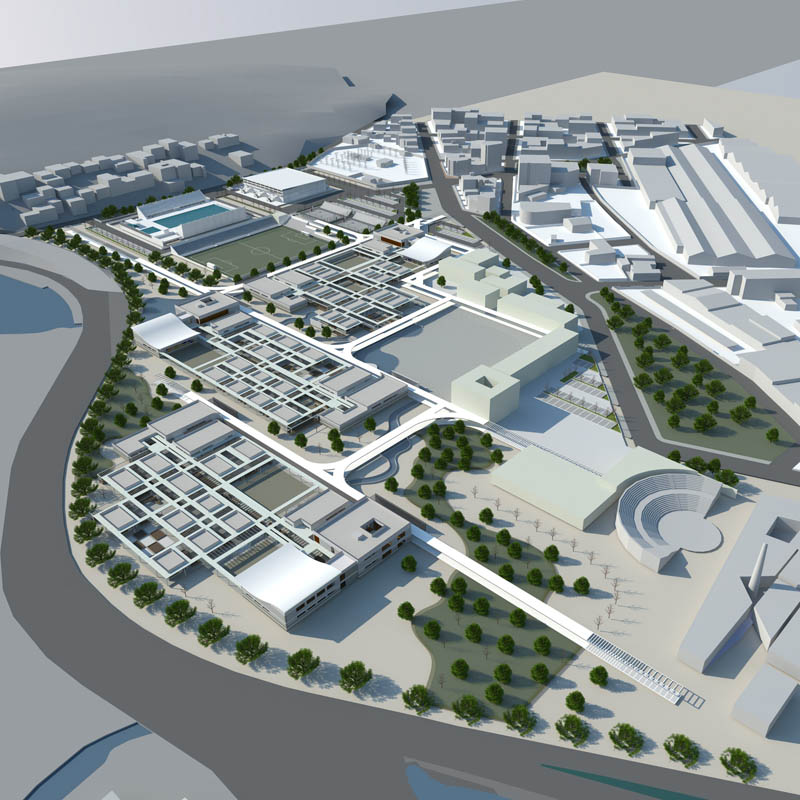

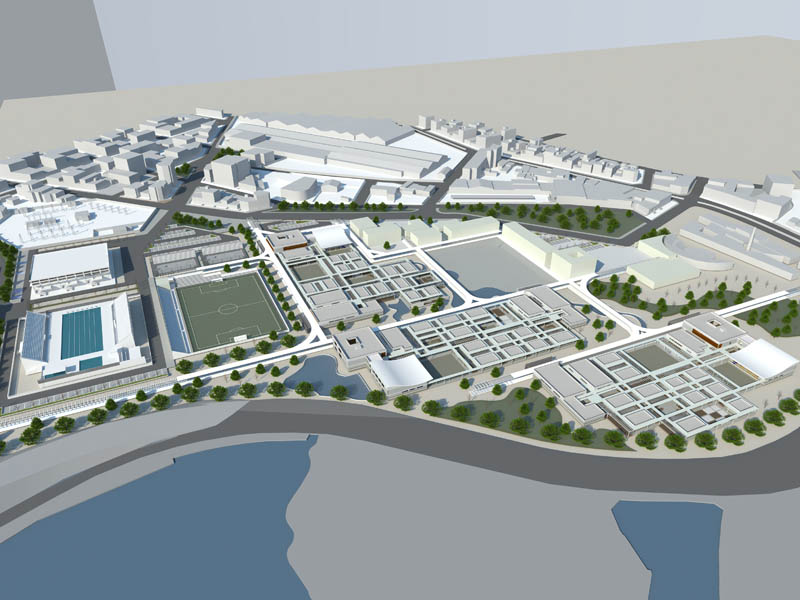

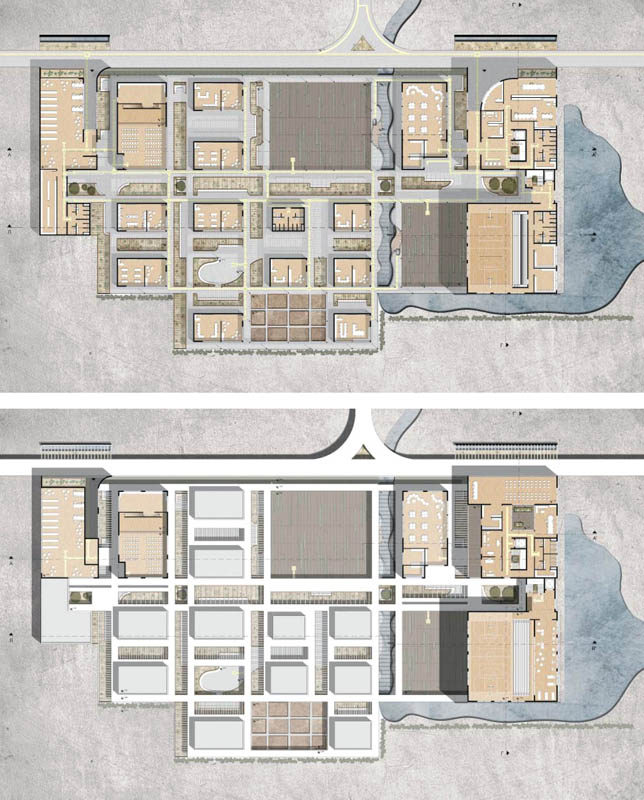

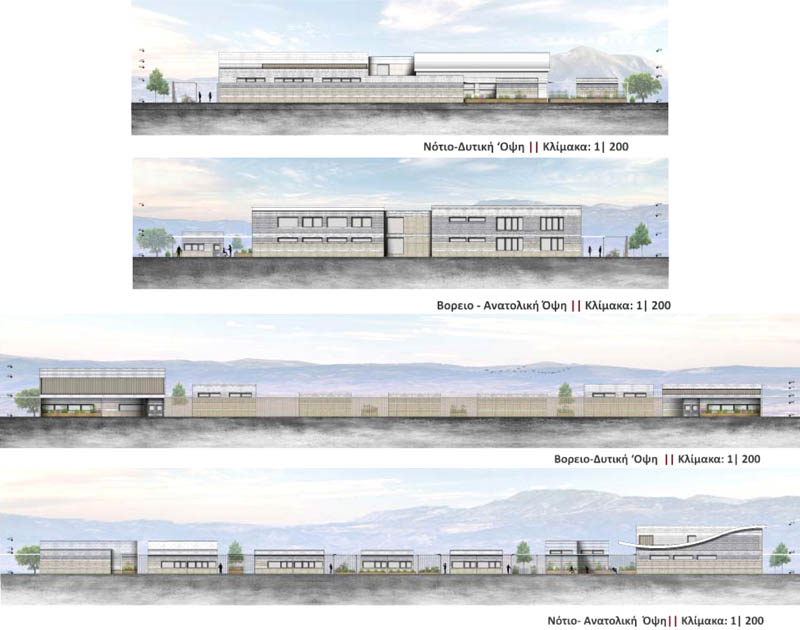

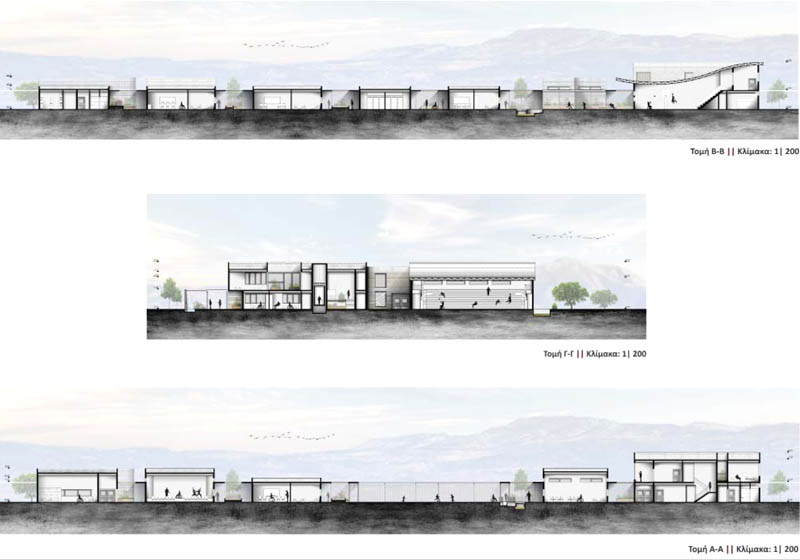

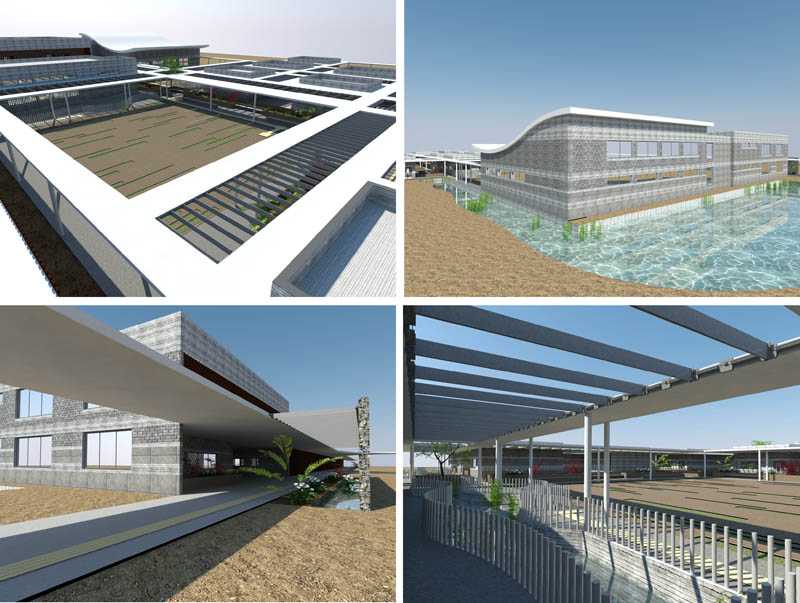

The research that preceded led gradually to an effort about an analysis of a synthetical procedure, associated with a real and important problem of the wider region of Central Greece and Evvoia. The Question: "Which is the target audience? 'Wants gradually to set both, the manner and the process of the design-thinking. That public has then the need of a complete education, customized and based on their own standards. People - children and teenagers- with special features face the world with all their senses, and perhaps more than the rest of us do. Sight, Touch, Hearing, Smell and taste are the channels of communication with the outside world. Via, or with the help of these, they can evolve their self and thus arises the need of a special education process, of a different kind than the standard. A special treatment based on how the human body works, and through interaction with the wider environment. There is therefore reason for a school, which is based on human senses, as a reading of existence, but also as an explanation of evolution. A comprehensive training that may lead the children from their first school steps, to the graduation. A special sensory school, with Primary and Secondary Education, may support students with different learning difficulties and peculiarities.
Supervisor: Trova Vasso
Reference Number: 526


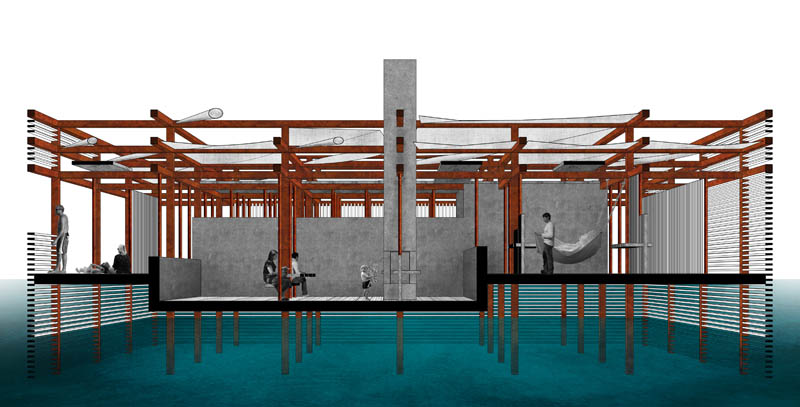

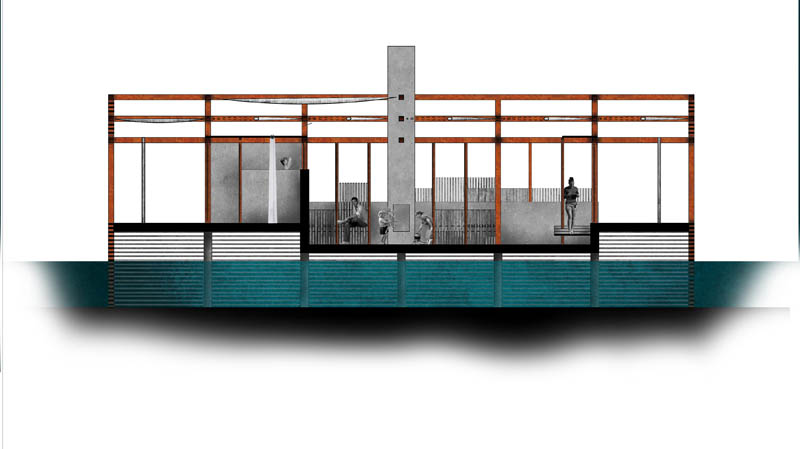





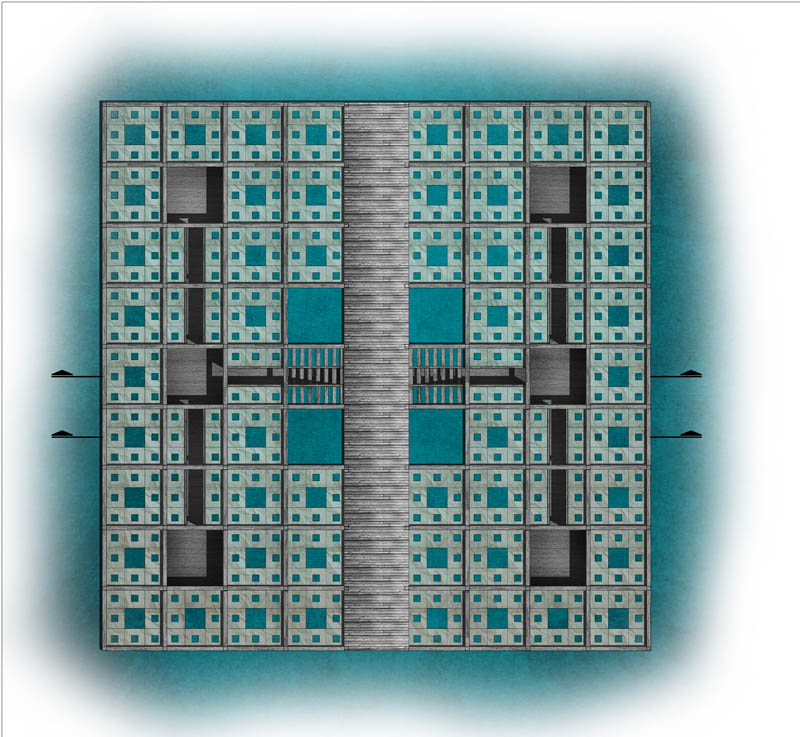

This thesis has the reinstated lake Karla as its subject. Recognizing the dual scale of the landscape (the lake existing as a technical project or infrastructure yet still being considered a piece of nature) the planned intervention is done in two levels, each complimenting the other.
On a larger scale, the system is organized as a quantified landscape, according to four grid levels projected on the landscape, each measuring a single dimension of the lake, producing a fabricated aspect of the landscape. On the smaller, human scale the intention to re-insert the embodied experience in the discovery of the lake by the visitor is carried out by proposing experiential platforms that work towards healing the environment as well as means of interpretation of the landscape and the way of life developed at the lake till its drying on 1962.
This habitational scenario is made complete with the addition of the typical boat of lake Karla, the platsida, as a means of travel but also as the basic habitational unit. Additionally, the basic habitational functions (dining, hygene e.t.c.) are placed on permanent structures at three points in the lake giving them a focal character. The system then takes on a more nomadic aspect with the ideas of travel and destination taking a special role.
Supervisor: Kotionis Zissis
Reference Number: 523
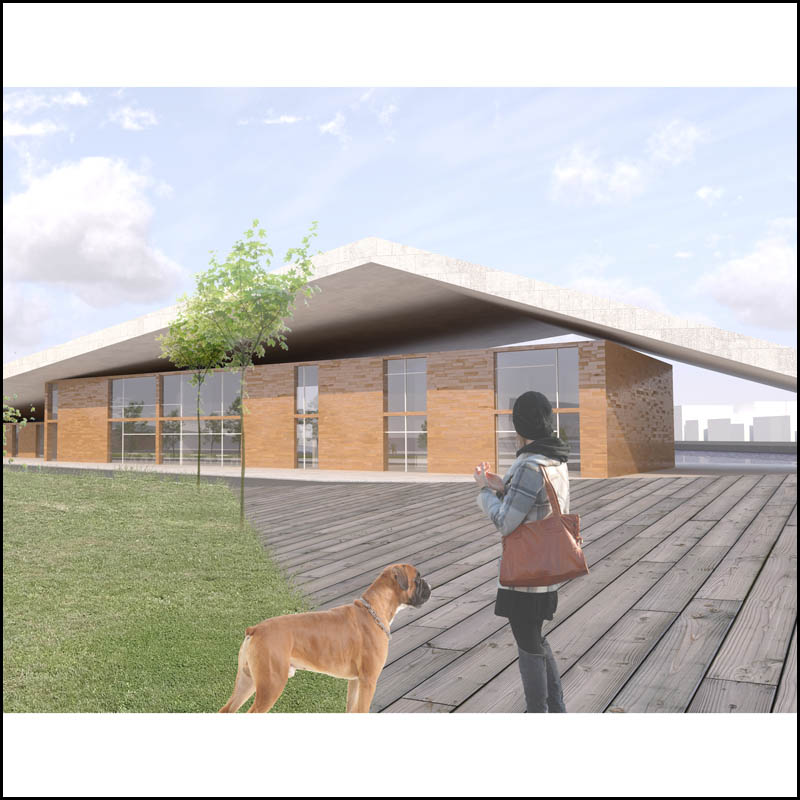

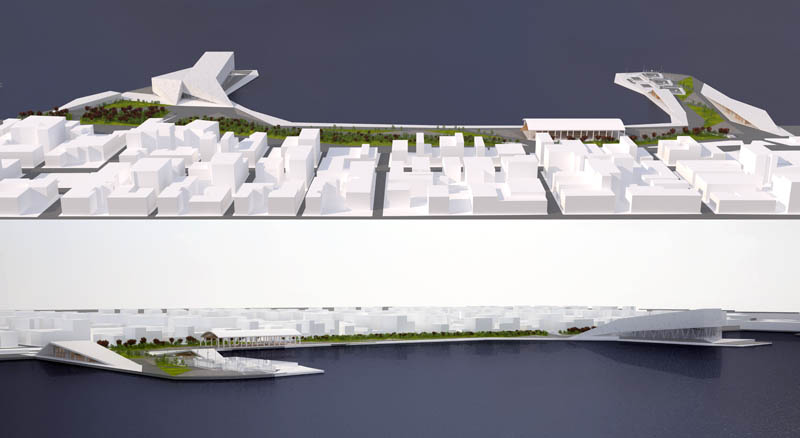

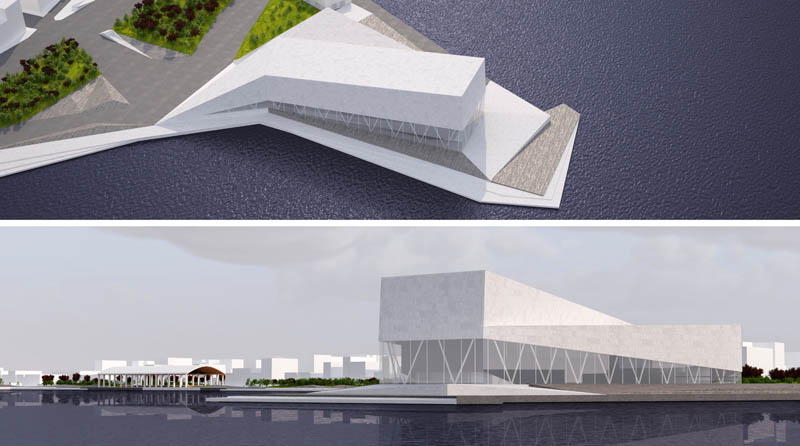

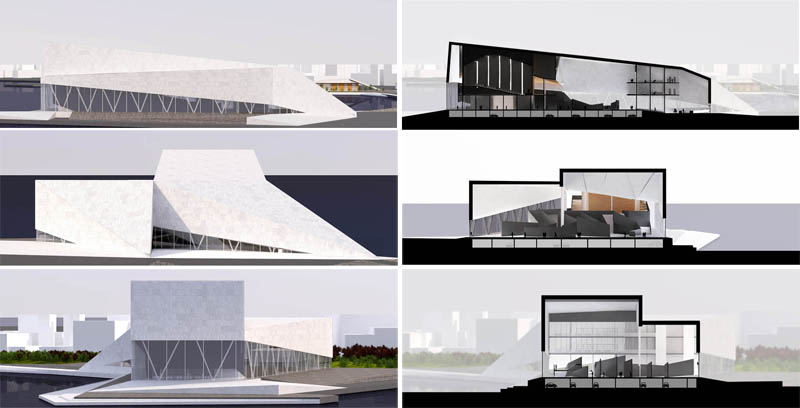





The main subject of this particular thesis, is the redesign of the waterfront of the city of Patras. Since a long time ago, the city has lost its relation with the sea, because the largest part of its waterfront, is taken over by the uses of the commercial and passenger port. But now, the city’s decision to relocate the passenger port onto another place of the city, frees up a big part of the city’s existing waterfront. So, the main goal is to make a realistic proposal, which will be structured by recognizing the area and its current situation, in order to establish all the uses that the area is in need and that will lead to an increased visiting rate of the city’s waterfront. Throughout the proposal, there is a presentation of the landscaping changes, that will generate big areas of trees and planting, and also spaces designed for the people to rest. Afterwards, all the plans of the proposed buildings are being presented, along with a series of sections and 3d images that demonstrate the idea at its best. The final proposal includes a cultural center - with auditorium, library and exposition spaces - an administrative center - with offices and meeting rooms - a commercial center - with bar, café, restaurant and an info point for the city - a sporting center - with tennis and basketball courts, a gym and locker room - and finally an open air food market that is established in one of the old warehouses of the port. All in all, what this proposal aims to achieve, is to rejuvenate and construct a strong relationship between the city and the sea, as every seaside city ought to have.
Supervisor: Triantafillidis Giorgos
Reference Number: 483
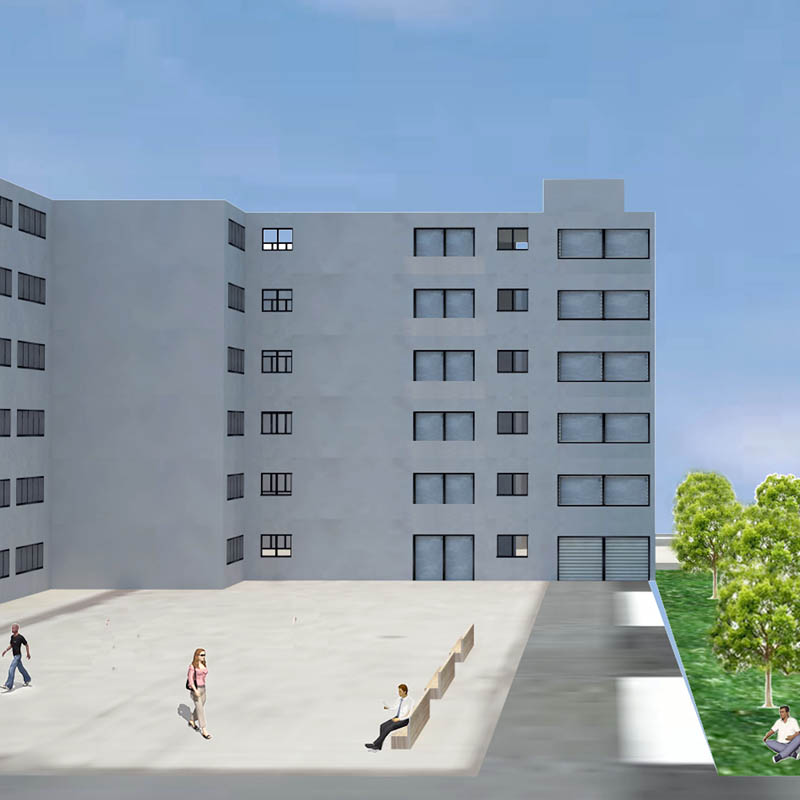











This work studies industrial zones during a crisis period and investigates their possibilities to accommodate a new collective model of labour based on the social needs. The study's goal is not an utopian solution, but a realistic answer.
The industrial zones were developed during the period of industry's growth as areas of concentration of factories structured without any plan. Following, they were transformed into planned zones where settlement incentives and advantages for industries were provided. However, de-industrialisation led to their gradual desolation, which, nowadays has peaked.
Focusing on the industrial zone of Volos, it is an almost desolate area, where the workforce is constantly diminishing, and factories cease their operation. The employment relations are changing with rotational work becoming predominant, while delayed payments are making their presence. Few units operate without problems. Consequently, there is a large reserve of buildings and skilled workforce, while at the same time there is a major unemployment issue.
The re-planning of the area is attempted, directed to a different concept for human labour based on some fundamental overall changes, such as the ownership regime and the possibility of worker's control. The industrial zone is transformed into an urban area of hyper-local character where industry and accommodation are combined, and which is an integral part of the city. Five research, education and production units are developed into existing buildings in subjects such as: technology, design, farming, materials and machinery. Housing is brought together at the limits of the zone's urban plots. Emphasis is given to the building of MISKO, as the landmark of the area. In the working areas, public uses are given and free entrance is permitted. Green parks are developed, public transportation is enhanced and a network of bicycle lanes is created. Finally, agricultural production is planned on urban gardens which are farmed by workers and residents.
Supervisor: Kotionis Zissis
Reference Number: 505


The thesis “Urban rooms in Didimoteicho” is based on archeological conclusions related to the name of the town Didimoteicho (“didimo”=twin and “teicho”=wall), a town on the borderline between Greece and Turkey.
The town lies between two hills (Castle of Kale and Agia Petra). Archaeological excavations in the second hill reveal buried Roman city era. Archaeologists claim a total destruction of the city in the 7th century forced the population to move to the nearest hill, the Castle of Kale. The new position is better fortified and so preferred. During this shift from the previous to the new position of the town, both hills were dwelled, and this is the condition under which the town is named Didimoteicho.
Archaeological finds from past centuries, distinct within the web of the town. They are found mostly at the level zero, giving to the ground a narrative power. The fact that the town never was a political center allows the characteristics of cultures to maintain without being expropriated.
The question Aristide Antonas poses after reading Flusser, about the relation between writing technology and architecture is something being investigated.
The concept of dipole was the dominant thought that has organized the design concept of the project, the dipole of the two hills, east - west, ground - roof, real - digital.
The final project entails flooring that unifies the path between the Castle of Kale and the hill of Agia Petra, underlying the common ground of the findings. Moreover, digital roofs are being inserted, visible only through Google Glass technology. They function like digital roof findings and lead the visitor to attraction points while constructing urban rooms.
Supervisor: Antonas Aristide
Reference Number: 509

